|
Displaying items by tag: British
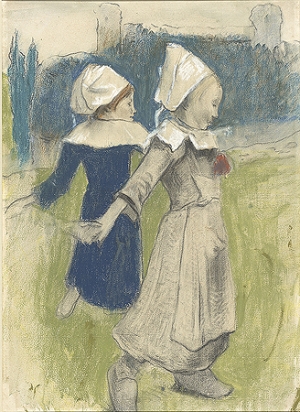
After acquiring a considerable number of important drawings, the Morgan Library & Museum in New York City has mounted an exhibition to showcase their recently added works. Spanning from the Renaissance through the 19th century, the drawings were acquired through gifts, purchases, and bequests. Over 100 of these works will be featured in Old Masters, Newly Acquired.
The Morgan has greatly improved its Impressionist, Post-Impressionist, and Symbolist holdings by acquiring a number of works by such artists as Édouard Manet (1832-1883), Paul Cézanne (1839-1906), Édouard Vuillard (1868-1940), and Odilon Redon (1840-1916). The museum also acquired over forty Danish drawings including sheets by several Golden Age masters including C.W. Eckersberg (1783-1853) and Johan Lundbye (181-1848). The Morgan added to their British watercolor collection with works by John Martin (1789-1854) and Samuel Palmer (1805-1881). William M. Griswold, director of the museum, said, “The Morgan’s collection of drawings is among the finest in the world, and the institution has been very fortunate to have long-standing relationships with some of America’s most important collectors. This exhibition celebrates their connoisseurship and their commitment to the Morgan.”
Old Masters, New Acquired will be on view at the Morgan Library & Museum through August 11, 2013.
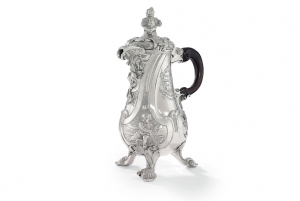
Christie’s London will offer a Rococo coffee-pot by Paul de Lamerie (1688-1751), the most celebrated British silversmith of the 18th century, as part of its Exceptional Sale on July 4, 2013. The George II silver coffee-pot, which was commissioned in 1738 by a wealthy London-based merchant, is expected to become the most valuable piece of English silver ever to be sold at auction. The masterpiece was recently the highlight of a British silver exhibition at the Metropolitan Museum of Art in New York.
Lamerie, who began his career in 1703 as an apprentice to the London goldsmith, Pierre Platel (1659-1739), opened his own workshop in 1713 and was soon appointed goldsmith to George I. His work evolved from simple Queen Anne styles to classical French designs, but his ornate Rococo works of the 1730s are his most admired pieces. Lamerie’s illustrious clientele included Sir Robert Walpole, King John V of Portugal, and Queen Elizabeth II, who he made a wedding gift for.
The coffee-pot heading to auction in July is expected to garner approximately $4.5 million.
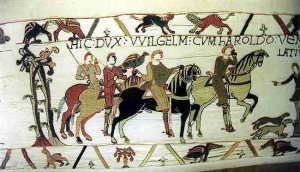
Residents of Alderney, the northernmost of the British Channel islands, recently came together to complete the Bayeux tapestry, an embroidered cloth measuring 230 feet from the 1070s. The original tapestry is believed to have been commissioned by Bishop Odo of Bayeux, the half brother of Duke William II of Normandy, and was sewn by English needle-works in either Winchester or Canterbury over a ten year span.
The Bayeux Tapestry is comprised of 50 scenes depicting the events leading up to the Norman conquest of England at the Battle of Hastings, where Duke William II defeated King Harold II of England. However, the tapestry ends before the coronation of William in London in 1066, leading experts to believe that the embroidery had lost its final panels over the centuries.
Hundred of people from Alderney have contributed to the completion of the Bayeux tapestry. Designed by artist Pauline Black, the project was overseen by Kate Russell, an American who lives on the island. Prince Charles and Camilla Parker Bowles even added a few stitches while on a visit to the Channel Islands.
The completed Bayeux tapestry will go on display at the Alderney Museum later this year.
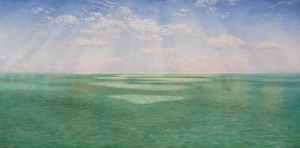
Looking at the View, a sweeping display of 300 years of British landscape painting, opened at London’s Tate Britain on February 12, 2013. The exhibition coincides with the re-opening of the Tate Britain galleries, which were closed for renovations.
The show is part of the museum’s BP British Art Displays, a series that highlights contemporary and historic British art from its collection. Curated by Tate Britain’s director Penelope Curtis, Looking at the View illustrates the different ways British artists have interpreted and portrayed their surroundings over the past three centuries. The exhibition features works from the Romantic and Pre-Raphaelite periods as well as paintings from the Land Art and other contemporary movements. Artists on view include J.M.W. Turner (1775-1851), John Brett (1831-1902), Henry Lamb (1883-1960), Lucian Freud (1922-2011), and Tracey Emin (b. 1963).
Looking at the View, which presents over 70 works by more than 50 artists, is arranged according to motif and draws connections between artists from vastly different time periods and movements. It is on view at Tate Britain through June 2, 2013.
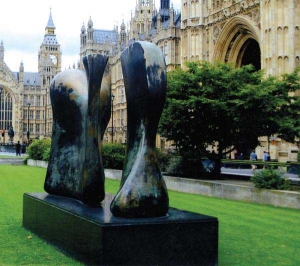
Henry Moore’s (1898-1986) severely damaged sculpture Knife Edge Two Piece (1965) will finally be restored according to the Parliamentary Art Collection. The sculpture, which is prominently displays outside of the Houses of Parliament in London, is England’s most revered work by the British sculptor.
Moore and the Contemporary Art Society donated Knife Edge Two Piece to England in 1967 but the work fell into disrepair after administrative changes left it with no legal owner. Eventually, the British government suggested that the House of Commons take ownership for the sculpture and that the Parliamentary Art Collection take responsibility for the its care.
The bronze sculpture, which is marred by discoloration, deterioration, and incised graffiti, will undergo conservation beginning February 16, 2013. Conservator Rupert Harris will lead the effort, which involves removing the sculpture’s protective lacquer and abrading its surface to eliminate the damage. The work will then be repatinated and treated with wax in order to protect it from future environmental damage.
The conservation project is expected to cost a little over $50,000 with most of the funding coming from the Parliamentary Art Collection. The Henry Moore Foundation will contribute about $17,000 to the effort. The Knife Edge Two Piece restoration project is expected to reach completion at the end of March 2013.
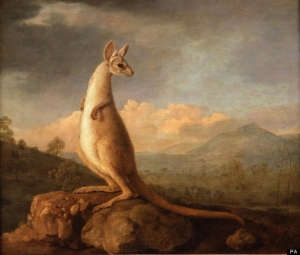
The British government has placed a temporary export bar on two important oil paintings by George Stubbs (1724-1806), an English painter best know for his depictions of horses. The works, which went on display at London’s Royal Academy in 1773, gave the British public their first glimpse of a kangaroo and a dingo.
Since Stubbs was unable to paint the animals, which are native to Australia, from life, he created Kongouro from New Holland (The Kangaroo) (1772) and Portrait of a Large Dog (The Dingo) (1772) from spoken accounts. He also made sketches of the kangaroo after inflating the animal’s preserved skin. Stubbs won praise for bringing the likenesses of the foreign animals to the British public for the first time. It is believed that Sir Joseph Banks commissioned the paintings after assisting in Captain James Cook’s first voyage to the Pacific.
Culture Minister Ed Vaizey announced the temporary export bar on Wednesday, February 6, 2013 following a recommendation by the Reviewing Committee On The Export of Works of Art and Objects of Cultural Interest. The ban will remain in place until August 5, 2013 and may be extended until November 5, 2013. Potential buyers will need $8.6 million to keep the paintings in Britain.
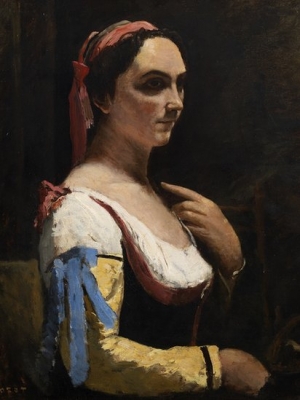
The late German-born British painter, Lucian Freud (1922-2011), specified in his will that his private art collection was to be donated to British museums rather than burdening his family with an inheritance tax after his death. The bequest is part of a British law that allows “acceptance in lieu” of taxes for authors, artists, and collectors.
Considered one of Britain’s greatest painters best known for his portraits and figurative works, Freud owned a number of important masterpieces including Jean-Baptiste Camille Corot’s (1796-1875) Femme á la Manche Jaune (The Italian Woman or Woman with Yellow Sleeve) and three bronze sculptures by Edgar Degas (1834-1917). It has been determined that the Corot painting, which has not been on public view in over 60 years, will go to the National Gallery in London and the Degas sculptures, Horse Galloping on Right Foot, La Masseuse, and Portrait of a Woman Head Resting on One Hand, will go to Somerset House’s Courtauld Gallery.
The donation is a thank you of sorts from Freud to Britain. The grandson of Sigmund Freud, Lucian escaped Hitler’s wrath when he came to England as a child. He became a British citizen in 1939.
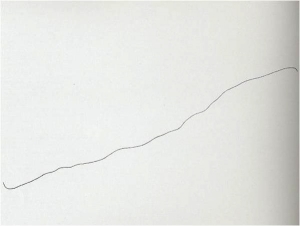
It was recently revealed that a Joan Miró (1893-1983) painting, which was damaged while on view at the Tate Modern in London, cost British taxpayers $326,000 to repair. Part of the museum’s retrospective of the Spanish modern artist, Painting on White Background for the Cell of a Recluse I (1968), was damaged when a visitor placed both hands against the work to steady himself after tripping and falling in the museum.
A white canvas sliced by a delicately wavering gray line, Cell of a Recluse I is one of five rare triptychs by Miró, which were exhibited together for the first time during the Tate retrospective in 2011. The work was immediately repaired after the incident, which left the acrylic on canvas painting with dents and markings. Cell of a Recluse I was on loan to the Tate from Barcelona’s Joan Miró Foundation and the British government paid the Foundation over $300,000 to cover the repair costs for the painting and to account for any loss in the work’s value due to the incident.
The Tate has recently been responsible for a string of damaged artworks including Mark Rothko’s (1903-1970) Black on Maroon (1958), which was defaced by a visitor, an early work by Roy Lichtenstein (1923-1977) titled Whaam! (1963), which was also marred by a museum patron, and a portrait of Margaret Thatcher by Helmut Newton (1920-2004), which was damaged when a staff member slipped and cracked the photograph’s glass frame.
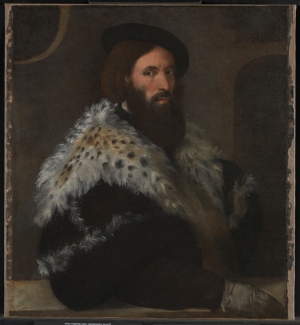
A painting by the Italian master Tiziano Vecellio (circa 1488/1490-1576), who is known in English as Titian, was recently discovered in London’s National Gallery. Located in Trafalgar Square, the museum houses the country’s collection of Western European paintings from the 13th to 19th centuries.
The portrait by Titian, a pivotal member of the 16th century Venetian school of painters, depicts Girolamo Fracastoro, a well-respected doctor at the time, draped in lynx fur. The National Gallery has owned the portrait of Fracastoro since 1924 but until recently attribution has been uncertain. The Fracastoro portrait underwent thorough restoration, revealing new information about the canvas and technique, prompting scholars and curators to uphold the attribution.
The painting is now being displayed as part of the National Gallery’s main collection. The portrait of Fracastoro is the third Titian painting to join the museum’s holdings since 2009 making the National Gallery’s Titian collection one of the finest in the world.
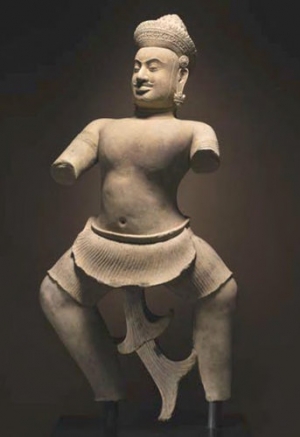
British art collector, Douglas A.J. Latchford, has spent decades building his reputation as one of the foremost experts in Khmer antiquities. Latchford, a resident of Thailand, was knighted in 2008 by the Cambodian government for admirably returning 14th-century Khmer artifacts.
In sharp contrast to his previous accolades, Latchford is currently the subject of a civil complaint files by the U.S. attorney’s office. Federal lawyers state that Latchford, referred to in proceedings as “the Collector,” bought a 10th century Khmer warrior statue known as the Duryodhana in the 1970s knowing that it had been looted from a temple during the Cambodian civil war.
While Latchford denies ever having owned the work, court papers claim that he purchased the statue from a Thai dealer who acquired the work from an organized looting network. Allegedly, Latchford then helped get the piece into Britain by concealing what was actually being shipped. Upon its arrival to the U.K., the auction house Spink & Son sold the statue to a Belgian collector in 1975. The collector’s widow is the Duryodhana’s current owner.
The widow approached Sotheby’s New York in 2010, hoping to sell the 500-pound sandstone statue. However, the sale was put on hold because of objections from the Cambodian government. While lawyers are hoping to return the work to Cambodia, the auction house still plans on selling the treasure, stating that there is no evidence to prove that the statue was looted or that it is the property of the Cambodian government.
Latchford has been collecting Cambodian antiquities for over 55 years and has donated many works to well-known institutions, including the National Museum in Phnom Penh and the Metropolitan Museum of Art. A judge is expected to rule on the Duryodhana case within the next few months.
|
|
|
|
|